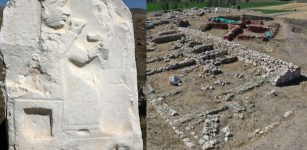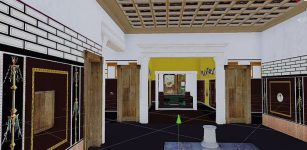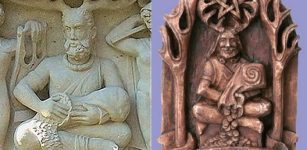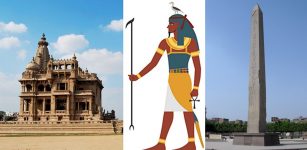Nebra Disc – Artifact That Represents 3,600-Year-Old Astronomical Knowledge
A. Sutherland - AncientPages.com - A controversial Bronze Age disc known as the Nebra Sky Disc is one of the most fascinating and perhaps some would say, disputable archaeological finds of recent years.
It has been suggested that this old artifact represents 3,600 years old astronomical knowledge.
However, there are doubts that the Nebra disc was used by prehistoric astronomers as a precision tool for gazing at the sky.
Was the Nebra Sky Disc the first true representation of the cosmos, used for measuring astronomical phenomena, or was it a tool used for shamanistic rituals?
"It's a difficult question to answer, but I do not think it was used as an instrument used for observing objects in the sky," said Curt Roslund, an astronomer at Gothenburg, Sweden. He argues that few features on the disc tend towards exact representation and that it is more likely to have been of symbolic value - perhaps used in shamanic rituals.
So what exactly is the Nebra disc and what was it used for?
Dated to 1600 BC, this bronze disc with gold-leaf decorations has a diameter of 32 cm and weighs around 4 pounds. It is painted blue-green and embossed with gold leaf symbols of the Moon, Sun and stars, and a curved gold band (interpreted as a sun boat) and an additional gold band on the edge of the disc, which probably represents one of the horizons.
It was discovered by some treasure hunters using a metal detector in a prehistoric area of Mittelberg Hill near Nebra, a small town in the district of Burgenlandkreis of Saxony-Anhalt, 112 miles southwest of Berlin, Germany. Along with the disc, the hunters discovered two swords, two axes, a chisel, and fragments of armlets.
The discoverers' unprofessional removal from the ground, unfortunately, damaged the fragile disc's outer rim and one of its 32 stars was lost.
Was the disc once attached to something?
Many researchers believe the disc is the oldest known representation of the cosmos. Was the Nebra Disc once an astronomical instrument to determine planting and harvest times for an agricultural society who lived in Bronze Age? It has been determined, the angle between the pair of arcs on either side of the disc is exactly 82 degrees.
Does it relate to the sun's passage across the sky in central Europe which measures also exactly 82 degrees?
Credit: MessageToEagle.com/AncientPages.com
The pair of arcs may represent the sun solstices for Mittelberg Hill, where in fact the disc was found. It would mean that the Bronze Age people of central Europe were able to make very advanced celestial measurements much earlier than diverse textbooks suggested.
Since 2004, at least, the Nebra Disc has remained a subject of deep controversy.
On the contrary, the Nebra Disc is old and genuine. Numerous tests conducted by the Institute for Archaeological Research in Halle, Germany showed the artifact's true antiquity. It has been concluded that the artifact represents a complex astronomical clock for the synchronization of solar and lunar calendars.
We must not forget that the sky disc of Nebra was found near Europe's oldest observatory in Goseck - first identified from aerial photographs.
Goseck represents the remains of what is thought to be Europe's oldest observatory that consists of a huge circle, 246 feet in diameter, and is dated to approximately 4900 BC.
Were the intriguing details on the disc-based on previous sky observations made by the ancients gathered at the primitive observatory at Goseck?
Written by – A. Sutherland - AncientPages.com Senior Staff Writer
Copyright © AncientPages.com All rights reserved. This material may not be published, broadcast, rewritten or redistributed in whole or part without the express written permission of AncientPages.com
More From Ancient Pages
-
 Mummification In Europe May Be Older Than Previously Known – 8,000-Year-Old Evidence Presented
Archaeology | Mar 4, 2022
Mummification In Europe May Be Older Than Previously Known – 8,000-Year-Old Evidence Presented
Archaeology | Mar 4, 2022 -
 One Of The Biggest Bronze Age Settlements On Orkney – Discovered
Archaeology | Dec 11, 2015
One Of The Biggest Bronze Age Settlements On Orkney – Discovered
Archaeology | Dec 11, 2015 -
 Aztec Treasure: ‘Yew Of Gold’ Found 39 Years Ago Originates From Spanish Plunder During ‘Sad Night’ In 1520
Archaeology | Jan 12, 2020
Aztec Treasure: ‘Yew Of Gold’ Found 39 Years Ago Originates From Spanish Plunder During ‘Sad Night’ In 1520
Archaeology | Jan 12, 2020 -
 Ancient Hittite Temple Dedicated To The Goddess Of Night To Be Unearthed
Archaeology | Oct 2, 2021
Ancient Hittite Temple Dedicated To The Goddess Of Night To Be Unearthed
Archaeology | Oct 2, 2021 -
 Early Christian Crypt Unearthed In Zaldapa Fortress, Bulgaria
News | Sep 7, 2015
Early Christian Crypt Unearthed In Zaldapa Fortress, Bulgaria
News | Sep 7, 2015 -
 A Unique Look Inside An Ancient Home In Pompeii Re-Constructed With Virtual Reality
News | Mar 26, 2022
A Unique Look Inside An Ancient Home In Pompeii Re-Constructed With Virtual Reality
News | Mar 26, 2022 -
 Enigmatic Cernunnos – Most Ancient, Stag-Antlered, Peaceful God Of Celtic People
Celtic Mythology | Aug 26, 2019
Enigmatic Cernunnos – Most Ancient, Stag-Antlered, Peaceful God Of Celtic People
Celtic Mythology | Aug 26, 2019 -
 3,600-Year-Old Bronze Dagger Made By The Minoan Civilization Found On Ancient Shipwreck
Archaeology | Sep 13, 2024
3,600-Year-Old Bronze Dagger Made By The Minoan Civilization Found On Ancient Shipwreck
Archaeology | Sep 13, 2024 -
 Ancient African Empires’ Impact On Migration Revealed By Genetics
Archaeology | Mar 31, 2023
Ancient African Empires’ Impact On Migration Revealed By Genetics
Archaeology | Mar 31, 2023 -
 Mysterious Crypt Points To A Rosicrucian Secret That Was Never Meant To Be Revealed
Ancient Mysteries | Aug 1, 2024
Mysterious Crypt Points To A Rosicrucian Secret That Was Never Meant To Be Revealed
Ancient Mysteries | Aug 1, 2024 -
 Secrets Of Mount Shasta – One Of The Most Sacred Places On Earth
Ancient Mysteries | Oct 24, 2015
Secrets Of Mount Shasta – One Of The Most Sacred Places On Earth
Ancient Mysteries | Oct 24, 2015 -
 200 Tons Of Silver Hidden From The Romans On The Shores Of The River Lahn
Archaeology | Feb 23, 2023
200 Tons Of Silver Hidden From The Romans On The Shores Of The River Lahn
Archaeology | Feb 23, 2023 -
 Diver Says He Found Mysterious Underwater Ancient Tomb, Ruins And Artifacts Of An Unknown Advanced Civilization
Featured Stories | Oct 10, 2023
Diver Says He Found Mysterious Underwater Ancient Tomb, Ruins And Artifacts Of An Unknown Advanced Civilization
Featured Stories | Oct 10, 2023 -
 Geb – Egyptian God Of Earth And Member Of The Ennead – His Laughter Created Earthquakes
Egyptian Mythology | Feb 12, 2019
Geb – Egyptian God Of Earth And Member Of The Ennead – His Laughter Created Earthquakes
Egyptian Mythology | Feb 12, 2019 -
 Ensisheim Meteorite Is The Oldest Meteorite With A Precise Date Of Impact
Ancient History Facts | Jun 29, 2018
Ensisheim Meteorite Is The Oldest Meteorite With A Precise Date Of Impact
Ancient History Facts | Jun 29, 2018 -
 Why Were Actors Painted As Cats By Ukiyo-e Artists In Japan?
Ancient History Facts | Feb 11, 2020
Why Were Actors Painted As Cats By Ukiyo-e Artists In Japan?
Ancient History Facts | Feb 11, 2020 -
 Mystery Of The Lost Beverina Castle – Did Knights Templar Know Where It Was?
Ancient Mysteries | Jan 21, 2018
Mystery Of The Lost Beverina Castle – Did Knights Templar Know Where It Was?
Ancient Mysteries | Jan 21, 2018 -
 Yarilo (Jarilo): Slavic God Of Spring, Powerful Sexual Energy, Symbol Of Dying, Regeneration And Abundance
Featured Stories | May 7, 2019
Yarilo (Jarilo): Slavic God Of Spring, Powerful Sexual Energy, Symbol Of Dying, Regeneration And Abundance
Featured Stories | May 7, 2019 -
 Ancient Mystery Of Peculiar Nail With Six Faces And Six Eyes – Unusual Discovery In Borgholm Castle, Sweden
Artifacts | Jan 8, 2017
Ancient Mystery Of Peculiar Nail With Six Faces And Six Eyes – Unusual Discovery In Borgholm Castle, Sweden
Artifacts | Jan 8, 2017 -
 Ancient Persians Were Familiar With Chemical Warfare 2,000 Years Ago
Ancient History Facts | Jun 4, 2018
Ancient Persians Were Familiar With Chemical Warfare 2,000 Years Ago
Ancient History Facts | Jun 4, 2018



